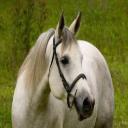Yahoo Answers is shutting down on May 4th, 2021 (Eastern Time) and beginning April 20th, 2021 (Eastern Time) the Yahoo Answers website will be in read-only mode. There will be no changes to other Yahoo properties or services, or your Yahoo account. You can find more information about the Yahoo Answers shutdown and how to download your data on this help page.
Trending News
How to solve a horse's pulling problem?
My 12 year old OTTB mare has a seriously annoying pulling problem that she's had ever since I've owned her. I got her from a rescue who said she was donated to them by a beginner rider who had no idea how to handle her and I've come to find she has a wealth of issues from that. The one I'm really wanting to fix is her habit of pulling her head down when you're riding her as if to pull the reins out of your hands. I thought maybe she just didn't like having much contact on her bit but she does this even if you're walking around on the buckle. It's like she doesn't even think about it, its just become what she does every few minutes. Does anyone have any techniques to help with this? I was thinking I'd just get a martingale to help her realize herself that she's doing it, or maybe a different bit? I'm really not sure. Any ideas or tips would be appreciated :) thanks
I use a copper D Ring snaffle. I'm getting her a new bit anyway because this one squeaks something crazy and I can't handle it anymore :p
Also, if you think I should try a martingale, should I go running or standing?
5 Answers
- ?Lv 78 years agoFavorite Answer
Race horses have been trained to pull down against the bit. It helps in racing. That may be your mare's situation. Do not pull back as this will only encourage her to pull harder. When she puts her head down tap her on the belly to bring her head up instead of pulling back. If you are consistent she will get better. Be prepared for her to go forward when you tap her and let her do it. Then bring her back down as softly as you can without pulling. Arena work is helpful because you can use the wall to slow or stop her if she gets strong. You want to avoid pulling on her head as much as you possibly can. I would not use a harsh bit on her as you want her accepting the bit later and not getting behind it. A plain snaffle will work. You should teach her a one rein stop from the ground. Take her head around way over her back and don't let go until her feet stop. As soon as her feet stop moving let her head go and tell her she's a good girl. Do this in both directions. Then do it mounted. Every time you stop take her head one way and then the other making sure her feet are stopped. That way whenever she gets strong you can do a one rein stop without ever pulling straight back on her.
- 8 years ago
I second what JoAnn said. She is 100% correct. Please don't jump to a harsher bit or a martingale as I promise these will only add to her confusion and your frustration. What you're looking at here is re-training.
I worked as a gallop girl and a jockey for 5 years, and all racing stock are trained only to go forward and to pull against pressure. Being taught "woah" is rarely an option, and absolutely no work is put into teaching a horse to give to pressure, this just isn't a requirement for a working (racing TB). She' only doing what she knows and has been taught, and by the sounds of it (based on her history) she's never been correctly taught to work off the track.
Keep her in the snaffle or you really risk causing her greater problems. Using the exercises the JoAnn provided are a GREAT start, again I can't state this enough, you need to retrain her. Try to keep telling yourself that at this point, your mare doesn't know what you want from her.
Look into trainers (I like Clinton Anderson' approach to working with colts) and learn as much as you can about teaching her to give to bit pressure and bend laterally. This is a process and will take some time, be patient and if you feel overwhelmed or confused by the process look for help; videos, youtube and articles can all be great resources if you can't afford a trainer, but if you can, a trainer would be your greatest resource.
If done right, this is a great learning opportunity for you and your horse, but understand that it will take time, patience and some work. Learn as much as you can on this and teach her first before resorting to additional tools or aids (i.e.:harsher bit or martingale), as its quite likely she won't need them and they'll only add to confusion for her!
Good luck!
- 8 years ago
Funny that this question popped up here, because I was just reading about this earlier tonight.
The general consesus from the different places that I was looking said to first check the horse's teeth to make sure they aren't causing pain, and check to make sure the bit is fitted properly. If it isn't a physical problem, the solutions that came up the most were to:
A) Use a riding crop to bump her on the neck each time she pulls. (Obviously don't beat the daylights out of her though, it shouldn't cause physical pain.)
B) Use a western saddle, tie twine from the D rings on either side of the bit and wrap them around the horn of the saddle, loose enough to allow her to drop her head comfortably when moving, but tight enough that she can't pull all the way down, and when she tries, obviously she will get the bit.
C) Each time she does it, loosen one rein and with the other pull her into a tight circle a couple times.
And one person said they would try attatching side reins.
- BarefoottrimmerLv 78 years ago
My WB eventer used to pull on me when we would come to a halt. It was like I did not release him as fast as he wanted and he would almost pull me out of the saddle at first. His former owner used to ride him with a lot of contact and while I do not, he had the habit and I guess she never addressed it. I actually spoke to Ray Hunt about this and this is what he advised me to do. You have to be able to recognize your horse's body language that tells you she is about to pull. You take the reins in your hands, shorten up down in front of the saddle and make a bridge so that when the horse pulls on you, she runs into the block you have set up. You do not pull on her mouth and she will recognize that it is her fault for running into the blocked area and with time, the behavior will diminish and then it will go away altogether. And that is exactly what happened with my horse. I had to get my timing together and be able to feel when he was about to pull on me and at first, it was difficult because he is a big, powerful horse and he would pull hard even though he was pulling with his mouth/head and sometimes I would even come out of the saddle a bit, but with practice I perfected my timing and it did not take too long for him to stop altogether. Personally, I would never tie my horse's head down. It doesn't teach them anything. I want my horse to respond to me and be correct because it is the right thing, not because I am using force and/or pain to control him. I prefer my horses to be well trained and I do not use devices to give artificial results.
good luck with your horse.
- How do you think about the answers? You can sign in to vote the answer.
- 8 years ago
My mare kinda had this issue, and we just kept working with her, and she still kinda pulls bu not as bad as before. Also, what bit are you using? Some good bits to try are Waterfords because they don't have anything for your horse to grab on to, so they can't pull as much. This really helped my horse calm down a little bit. You might want to try a Boucher Waterford bit because the Boucher bit adds just the smallest amount of control and leverage, while the Waterford doesn't allow your horse to pull. Full cheek bits are good too because they apply support and stability to your horse. Good luck curing the issue!!
Source(s): Same issue with my horse





